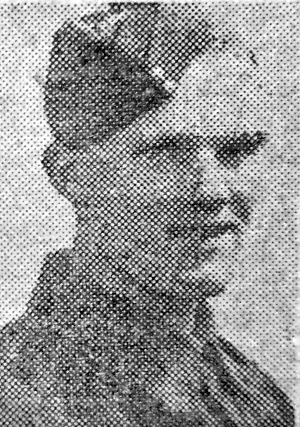
George Alfred Bastey was born in late 1914 in the Dewsbury area, the younger son of Bradford born miner Willie Bastey and Ethel Hardwick, who was born in Gomersal. The couple married at Tong St. James Church, Bradford on the 5th October 1907.
The Bastey family moved to Ossett in 1910, and by 1911 they were living at 106, Dewsbury Road, Ossett with two children. The couple had a further four children including George Alfred. The 1913-14 Ossett Burgess (North Ward) Rolls record that Willie Bastey was living at May Terrace , Leeds Road, Ossett and it is quite possible that his son, George Alfred, was born here in that latter year. The “Ossett Observer” dated 21st February 1948 records him being “formerly” of this address.
George Alfred Bastey married Florence Handley in Leeds in early 1940. The couple appear not to have had children. It seems probable that the widowed Florence married Thomas W. Lumley in Leeds in summer 1946.
The 1st Battalion of the York and Lancaster Regiment consisted Regular soldiers. The 1st Battalion was part of the 15th Infantry Brigade of the 5th Infantry Division and was sent to France in October 1939, a month after the outbreak of the Second World War, where it served as part of the British Expeditionary Force (BEF). The battalion fought briefly in the Norwegian Campaign in April 1940. After evacuation from Norway to the United Kingdom in May 1940, the battalion was sent to Scotland, later being posted to Northern Ireland in March 1942. The battalion then, after leaving the United Kingdom in March 1942 and being shipped around most of the British Empire and many Middle Eastern countries, was finally sent to the Mediterranean where they fought in the Allied invasion of Sicily in July/August 1943, followed in early September by the Allied invasion of Italy.
The “Ossett Observer” carried a report about the death of George Bastey:
“Ossett Soldier Killed – Private G. A. Bastey – A letter has been received from the War Office by Mrs. Bastey who is living at present at 12, New Inn Street, Wortley, Leeds, that her husband Private George Alfred Bastey (28), was killed in action in the Middle East on July 13th 1943.
A native of Ossett, and a son of Mr. and the late Mrs. W. Bastey, 6, May Terrace, Leeds Rd., Ossett, Private Bastey was educated at Chickenley Lane School and was afterwards employed successively at W. Greenwood and Sons Mill, Earlsheaton, and Shaw Cross, Hartley Bank, Crigglestone and Sharlston Collieries. He joined the Ossett Territorials in 1937 and transferred to the Regular Army a fortnight before the outbreak of the war, being attached to the York and Lancaster Regiment. He has served in India, Iraq, and latterly in the Middle East.
Well-known in Ossett, particularly in the North Ward, he was a member of Streetside Working Men’s Club, and was keenly interested in cycling, being a member of the local Clarion Club. He was married shortly after WW2 broke out. There are no children. He has a brother, Wilfred, who is serving with the Royal Engineers. Their father formerly worked at Low Laithes Colliery, Gawthorpe.”

Above: Newspaper report about the invasion of Sicily dated July 12th 1943.
Private George Bastey, aged 28 years, husband of Florence Bastey, of Wortley, Leeds, died on the 13th July 1943 and is buried at the Syracuse War Cemetery in Sicily.
On the 10th July 1943, following the successful conclusion of the north African campaign in mid May, a combined allied force of 160,000 Commonwealth and American troops invaded Sicily as a prelude to the assault on mainland Italy. The Italians, who would shortly make peace with the Allies and re-enter the war on their side, offered little determined resistance but German opposition was vigorous and stubborn. The campaign in Sicily came to an end on the 17th August 1943 when the two allied forces came together at Messina, but failed to cut off the retreating Axis lines.
Commonwealth forces made their landings in the south-east corner of the island between Pachina and Syracuse, and the majority of those buried in Syracuse War Cemetery died during those landings or in the early stages of the campaign. Many graves belong to men of the airborne force that attempted landings west of the town on the night of 9th and 10th July, when gale force winds forced 60 of the 140 gliders used into the sea and blew others wide of their objectives. Syracuse War Cemetery contains 1,059 Commonwealth burials of the Second World War, 134 of them unidentified. There is also one First World war burial, that of a merchant seaman whose grave was brought to the cemetery from Marsala British Cemetery.1
References: